Organisational Behaviour: Expectancy vs Reinforcement Theory
VerifiedAdded on 2023/02/01
|10
|3004
|34
Essay
AI Summary
This essay delves into the realm of organisational behaviour, defining it as the study of human behaviour within a business setting. It highlights the significance of understanding employee behaviour, emphasizing the role of expectancy and reinforcement theories. The essay critically analyzes these two theories, explaining how the expectancy theory focuses on employee expectations and the valence of outcomes, while the reinforcement theory emphasizes the impact of rewards and punishments on shaping behaviour. The essay further examines the interconnectedness of these theories, asserting that effective organisational behaviour strategies must consider both employee expectations and the use of rewards to enhance job satisfaction and performance. The essay concludes by reiterating the importance of organisational behaviour in influencing employee conduct and aligning it with organisational goals.
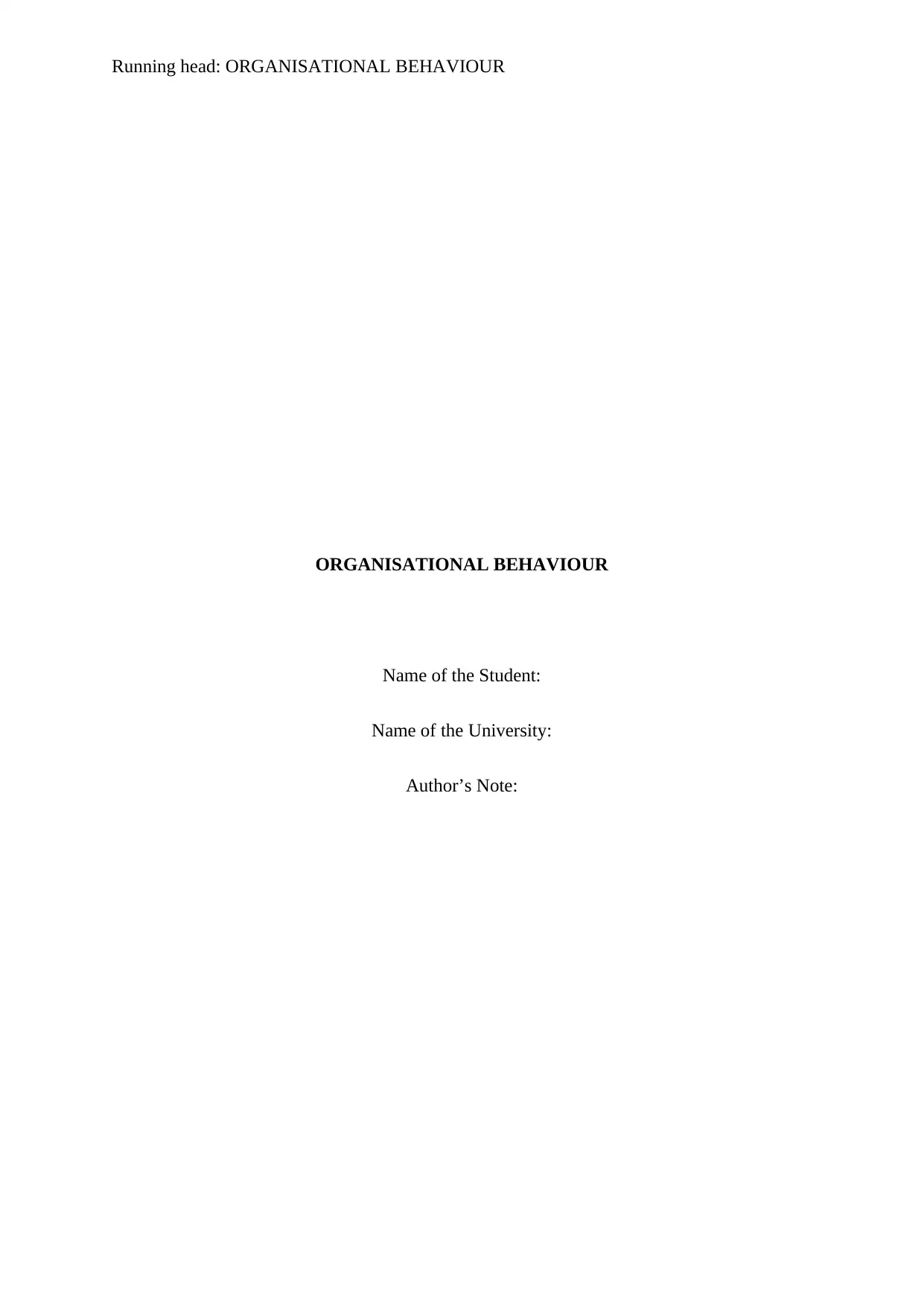
Running head: ORGANISATIONAL BEHAVIOUR
ORGANISATIONAL BEHAVIOUR
Name of the Student:
Name of the University:
Author’s Note:
ORGANISATIONAL BEHAVIOUR
Name of the Student:
Name of the University:
Author’s Note:
Paraphrase This Document
Need a fresh take? Get an instant paraphrase of this document with our AI Paraphraser
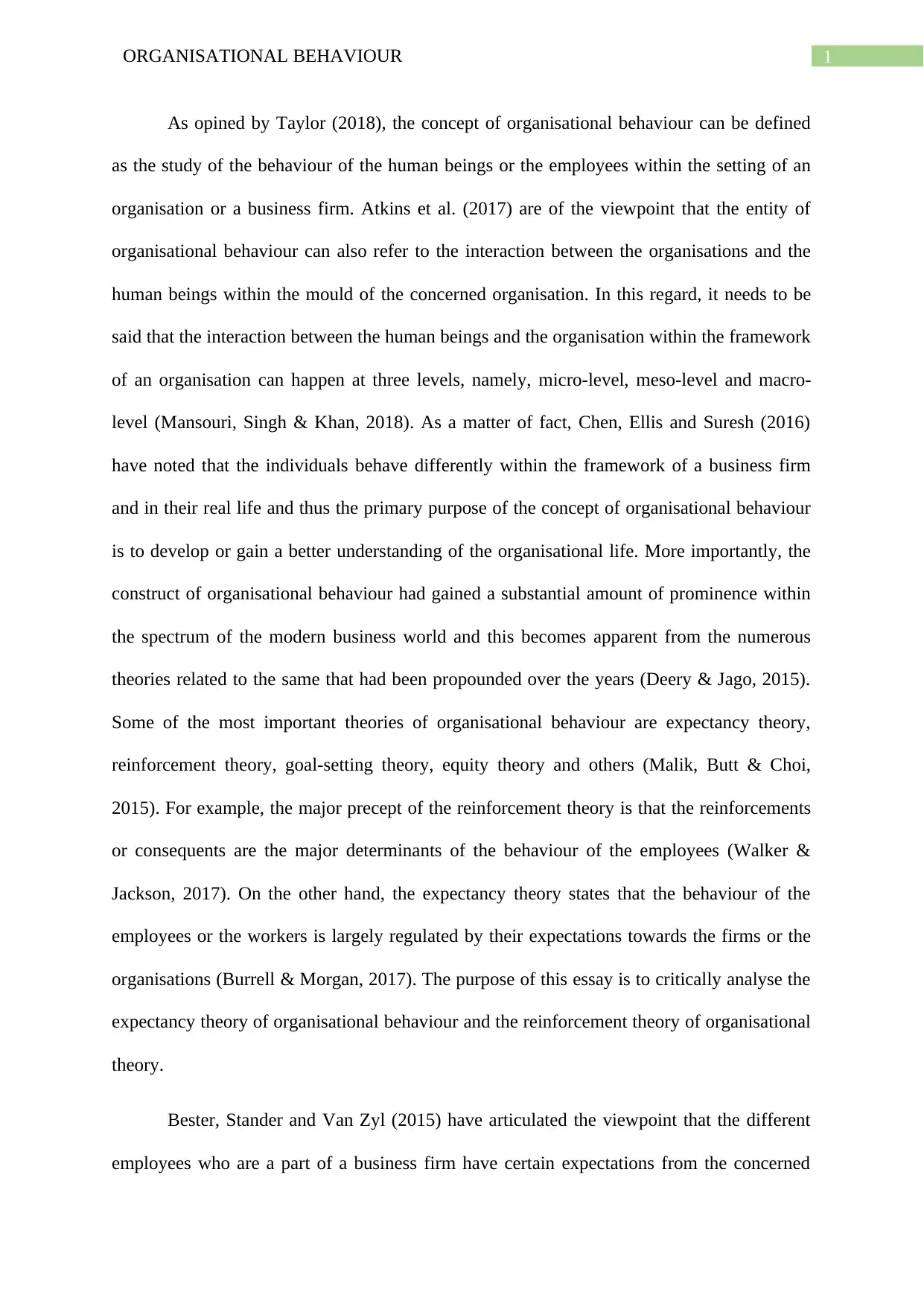
1ORGANISATIONAL BEHAVIOUR
As opined by Taylor (2018), the concept of organisational behaviour can be defined
as the study of the behaviour of the human beings or the employees within the setting of an
organisation or a business firm. Atkins et al. (2017) are of the viewpoint that the entity of
organisational behaviour can also refer to the interaction between the organisations and the
human beings within the mould of the concerned organisation. In this regard, it needs to be
said that the interaction between the human beings and the organisation within the framework
of an organisation can happen at three levels, namely, micro-level, meso-level and macro-
level (Mansouri, Singh & Khan, 2018). As a matter of fact, Chen, Ellis and Suresh (2016)
have noted that the individuals behave differently within the framework of a business firm
and in their real life and thus the primary purpose of the concept of organisational behaviour
is to develop or gain a better understanding of the organisational life. More importantly, the
construct of organisational behaviour had gained a substantial amount of prominence within
the spectrum of the modern business world and this becomes apparent from the numerous
theories related to the same that had been propounded over the years (Deery & Jago, 2015).
Some of the most important theories of organisational behaviour are expectancy theory,
reinforcement theory, goal-setting theory, equity theory and others (Malik, Butt & Choi,
2015). For example, the major precept of the reinforcement theory is that the reinforcements
or consequents are the major determinants of the behaviour of the employees (Walker &
Jackson, 2017). On the other hand, the expectancy theory states that the behaviour of the
employees or the workers is largely regulated by their expectations towards the firms or the
organisations (Burrell & Morgan, 2017). The purpose of this essay is to critically analyse the
expectancy theory of organisational behaviour and the reinforcement theory of organisational
theory.
Bester, Stander and Van Zyl (2015) have articulated the viewpoint that the different
employees who are a part of a business firm have certain expectations from the concerned
As opined by Taylor (2018), the concept of organisational behaviour can be defined
as the study of the behaviour of the human beings or the employees within the setting of an
organisation or a business firm. Atkins et al. (2017) are of the viewpoint that the entity of
organisational behaviour can also refer to the interaction between the organisations and the
human beings within the mould of the concerned organisation. In this regard, it needs to be
said that the interaction between the human beings and the organisation within the framework
of an organisation can happen at three levels, namely, micro-level, meso-level and macro-
level (Mansouri, Singh & Khan, 2018). As a matter of fact, Chen, Ellis and Suresh (2016)
have noted that the individuals behave differently within the framework of a business firm
and in their real life and thus the primary purpose of the concept of organisational behaviour
is to develop or gain a better understanding of the organisational life. More importantly, the
construct of organisational behaviour had gained a substantial amount of prominence within
the spectrum of the modern business world and this becomes apparent from the numerous
theories related to the same that had been propounded over the years (Deery & Jago, 2015).
Some of the most important theories of organisational behaviour are expectancy theory,
reinforcement theory, goal-setting theory, equity theory and others (Malik, Butt & Choi,
2015). For example, the major precept of the reinforcement theory is that the reinforcements
or consequents are the major determinants of the behaviour of the employees (Walker &
Jackson, 2017). On the other hand, the expectancy theory states that the behaviour of the
employees or the workers is largely regulated by their expectations towards the firms or the
organisations (Burrell & Morgan, 2017). The purpose of this essay is to critically analyse the
expectancy theory of organisational behaviour and the reinforcement theory of organisational
theory.
Bester, Stander and Van Zyl (2015) have articulated the viewpoint that the different
employees who are a part of a business firm have certain expectations from the concerned
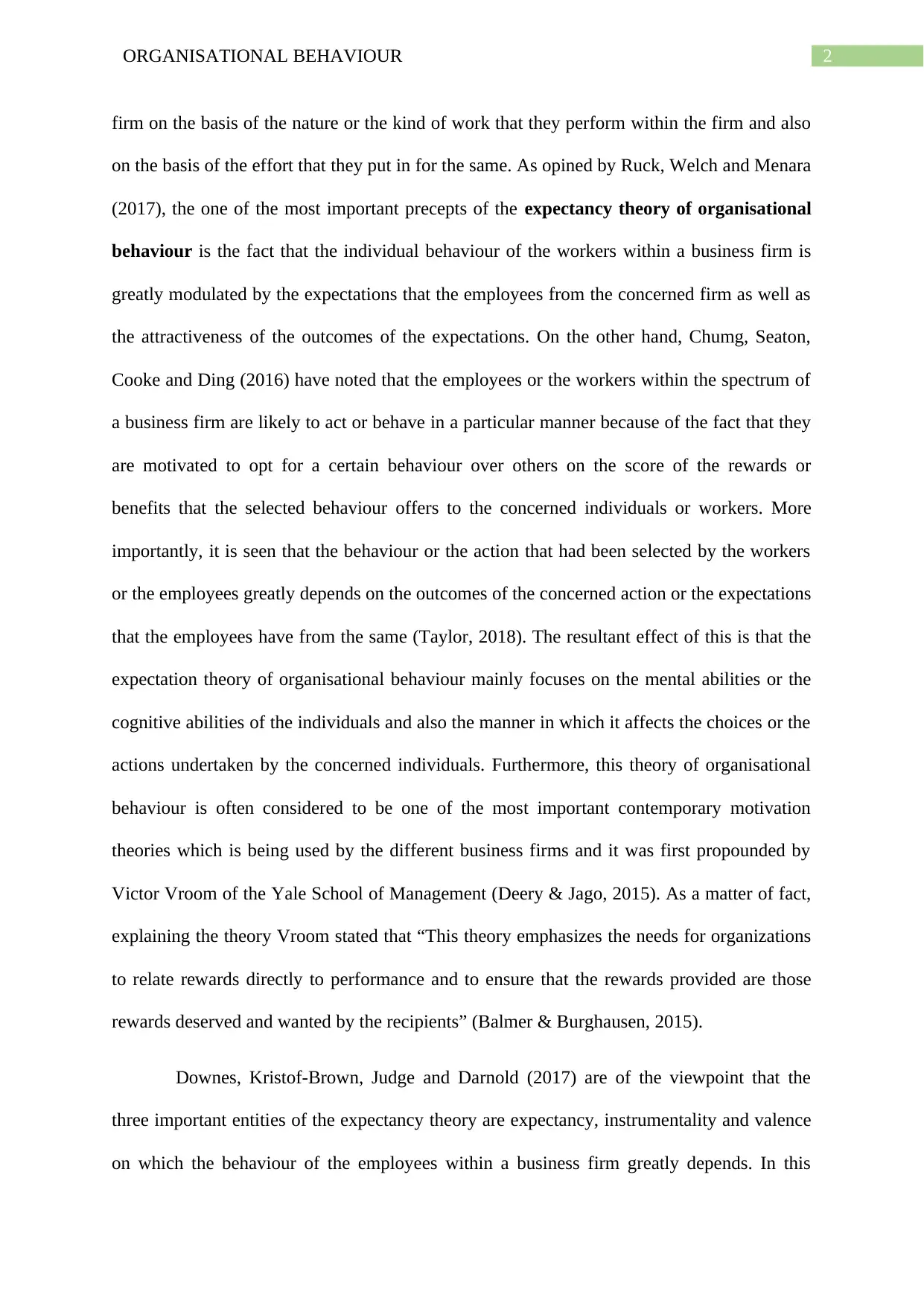
2ORGANISATIONAL BEHAVIOUR
firm on the basis of the nature or the kind of work that they perform within the firm and also
on the basis of the effort that they put in for the same. As opined by Ruck, Welch and Menara
(2017), the one of the most important precepts of the expectancy theory of organisational
behaviour is the fact that the individual behaviour of the workers within a business firm is
greatly modulated by the expectations that the employees from the concerned firm as well as
the attractiveness of the outcomes of the expectations. On the other hand, Chumg, Seaton,
Cooke and Ding (2016) have noted that the employees or the workers within the spectrum of
a business firm are likely to act or behave in a particular manner because of the fact that they
are motivated to opt for a certain behaviour over others on the score of the rewards or
benefits that the selected behaviour offers to the concerned individuals or workers. More
importantly, it is seen that the behaviour or the action that had been selected by the workers
or the employees greatly depends on the outcomes of the concerned action or the expectations
that the employees have from the same (Taylor, 2018). The resultant effect of this is that the
expectation theory of organisational behaviour mainly focuses on the mental abilities or the
cognitive abilities of the individuals and also the manner in which it affects the choices or the
actions undertaken by the concerned individuals. Furthermore, this theory of organisational
behaviour is often considered to be one of the most important contemporary motivation
theories which is being used by the different business firms and it was first propounded by
Victor Vroom of the Yale School of Management (Deery & Jago, 2015). As a matter of fact,
explaining the theory Vroom stated that “This theory emphasizes the needs for organizations
to relate rewards directly to performance and to ensure that the rewards provided are those
rewards deserved and wanted by the recipients” (Balmer & Burghausen, 2015).
Downes, Kristof-Brown, Judge and Darnold (2017) are of the viewpoint that the
three important entities of the expectancy theory are expectancy, instrumentality and valence
on which the behaviour of the employees within a business firm greatly depends. In this
firm on the basis of the nature or the kind of work that they perform within the firm and also
on the basis of the effort that they put in for the same. As opined by Ruck, Welch and Menara
(2017), the one of the most important precepts of the expectancy theory of organisational
behaviour is the fact that the individual behaviour of the workers within a business firm is
greatly modulated by the expectations that the employees from the concerned firm as well as
the attractiveness of the outcomes of the expectations. On the other hand, Chumg, Seaton,
Cooke and Ding (2016) have noted that the employees or the workers within the spectrum of
a business firm are likely to act or behave in a particular manner because of the fact that they
are motivated to opt for a certain behaviour over others on the score of the rewards or
benefits that the selected behaviour offers to the concerned individuals or workers. More
importantly, it is seen that the behaviour or the action that had been selected by the workers
or the employees greatly depends on the outcomes of the concerned action or the expectations
that the employees have from the same (Taylor, 2018). The resultant effect of this is that the
expectation theory of organisational behaviour mainly focuses on the mental abilities or the
cognitive abilities of the individuals and also the manner in which it affects the choices or the
actions undertaken by the concerned individuals. Furthermore, this theory of organisational
behaviour is often considered to be one of the most important contemporary motivation
theories which is being used by the different business firms and it was first propounded by
Victor Vroom of the Yale School of Management (Deery & Jago, 2015). As a matter of fact,
explaining the theory Vroom stated that “This theory emphasizes the needs for organizations
to relate rewards directly to performance and to ensure that the rewards provided are those
rewards deserved and wanted by the recipients” (Balmer & Burghausen, 2015).
Downes, Kristof-Brown, Judge and Darnold (2017) are of the viewpoint that the
three important entities of the expectancy theory are expectancy, instrumentality and valence
on which the behaviour of the employees within a business firm greatly depends. In this
⊘ This is a preview!⊘
Do you want full access?
Subscribe today to unlock all pages.

Trusted by 1+ million students worldwide
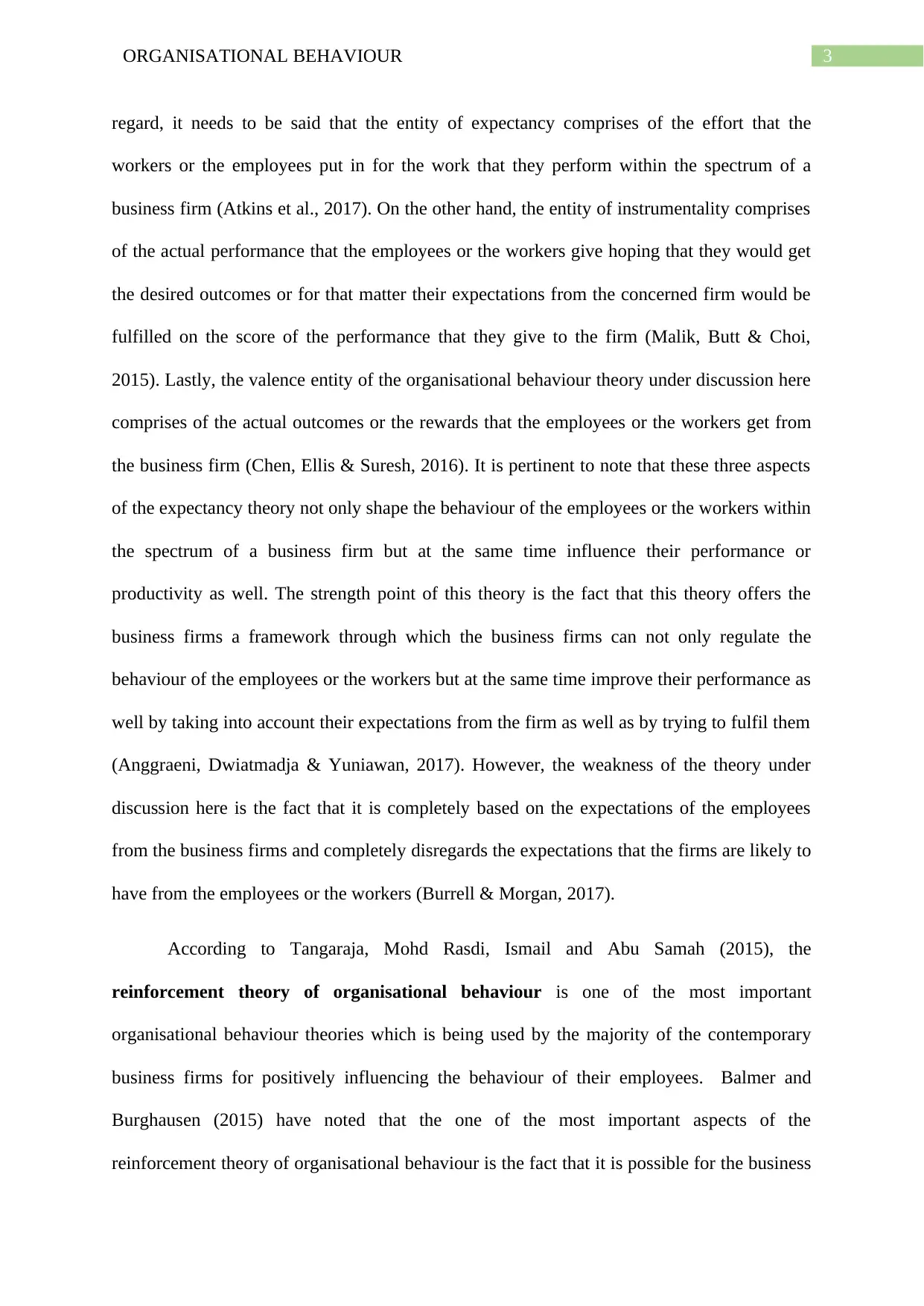
3ORGANISATIONAL BEHAVIOUR
regard, it needs to be said that the entity of expectancy comprises of the effort that the
workers or the employees put in for the work that they perform within the spectrum of a
business firm (Atkins et al., 2017). On the other hand, the entity of instrumentality comprises
of the actual performance that the employees or the workers give hoping that they would get
the desired outcomes or for that matter their expectations from the concerned firm would be
fulfilled on the score of the performance that they give to the firm (Malik, Butt & Choi,
2015). Lastly, the valence entity of the organisational behaviour theory under discussion here
comprises of the actual outcomes or the rewards that the employees or the workers get from
the business firm (Chen, Ellis & Suresh, 2016). It is pertinent to note that these three aspects
of the expectancy theory not only shape the behaviour of the employees or the workers within
the spectrum of a business firm but at the same time influence their performance or
productivity as well. The strength point of this theory is the fact that this theory offers the
business firms a framework through which the business firms can not only regulate the
behaviour of the employees or the workers but at the same time improve their performance as
well by taking into account their expectations from the firm as well as by trying to fulfil them
(Anggraeni, Dwiatmadja & Yuniawan, 2017). However, the weakness of the theory under
discussion here is the fact that it is completely based on the expectations of the employees
from the business firms and completely disregards the expectations that the firms are likely to
have from the employees or the workers (Burrell & Morgan, 2017).
According to Tangaraja, Mohd Rasdi, Ismail and Abu Samah (2015), the
reinforcement theory of organisational behaviour is one of the most important
organisational behaviour theories which is being used by the majority of the contemporary
business firms for positively influencing the behaviour of their employees. Balmer and
Burghausen (2015) have noted that the one of the most important aspects of the
reinforcement theory of organisational behaviour is the fact that it is possible for the business
regard, it needs to be said that the entity of expectancy comprises of the effort that the
workers or the employees put in for the work that they perform within the spectrum of a
business firm (Atkins et al., 2017). On the other hand, the entity of instrumentality comprises
of the actual performance that the employees or the workers give hoping that they would get
the desired outcomes or for that matter their expectations from the concerned firm would be
fulfilled on the score of the performance that they give to the firm (Malik, Butt & Choi,
2015). Lastly, the valence entity of the organisational behaviour theory under discussion here
comprises of the actual outcomes or the rewards that the employees or the workers get from
the business firm (Chen, Ellis & Suresh, 2016). It is pertinent to note that these three aspects
of the expectancy theory not only shape the behaviour of the employees or the workers within
the spectrum of a business firm but at the same time influence their performance or
productivity as well. The strength point of this theory is the fact that this theory offers the
business firms a framework through which the business firms can not only regulate the
behaviour of the employees or the workers but at the same time improve their performance as
well by taking into account their expectations from the firm as well as by trying to fulfil them
(Anggraeni, Dwiatmadja & Yuniawan, 2017). However, the weakness of the theory under
discussion here is the fact that it is completely based on the expectations of the employees
from the business firms and completely disregards the expectations that the firms are likely to
have from the employees or the workers (Burrell & Morgan, 2017).
According to Tangaraja, Mohd Rasdi, Ismail and Abu Samah (2015), the
reinforcement theory of organisational behaviour is one of the most important
organisational behaviour theories which is being used by the majority of the contemporary
business firms for positively influencing the behaviour of their employees. Balmer and
Burghausen (2015) have noted that the one of the most important aspects of the
reinforcement theory of organisational behaviour is the fact that it is possible for the business
Paraphrase This Document
Need a fresh take? Get an instant paraphrase of this document with our AI Paraphraser
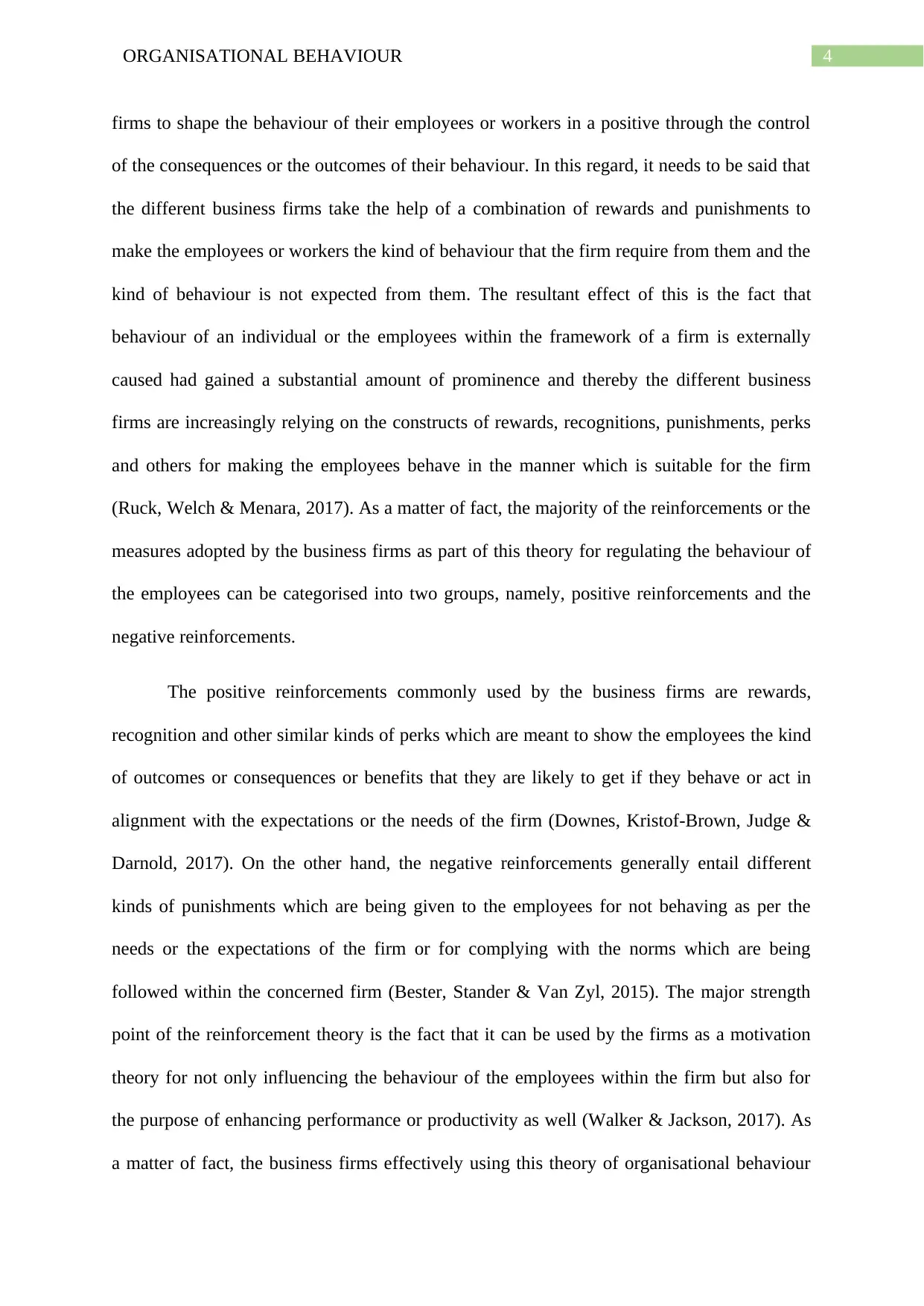
4ORGANISATIONAL BEHAVIOUR
firms to shape the behaviour of their employees or workers in a positive through the control
of the consequences or the outcomes of their behaviour. In this regard, it needs to be said that
the different business firms take the help of a combination of rewards and punishments to
make the employees or workers the kind of behaviour that the firm require from them and the
kind of behaviour is not expected from them. The resultant effect of this is the fact that
behaviour of an individual or the employees within the framework of a firm is externally
caused had gained a substantial amount of prominence and thereby the different business
firms are increasingly relying on the constructs of rewards, recognitions, punishments, perks
and others for making the employees behave in the manner which is suitable for the firm
(Ruck, Welch & Menara, 2017). As a matter of fact, the majority of the reinforcements or the
measures adopted by the business firms as part of this theory for regulating the behaviour of
the employees can be categorised into two groups, namely, positive reinforcements and the
negative reinforcements.
The positive reinforcements commonly used by the business firms are rewards,
recognition and other similar kinds of perks which are meant to show the employees the kind
of outcomes or consequences or benefits that they are likely to get if they behave or act in
alignment with the expectations or the needs of the firm (Downes, Kristof-Brown, Judge &
Darnold, 2017). On the other hand, the negative reinforcements generally entail different
kinds of punishments which are being given to the employees for not behaving as per the
needs or the expectations of the firm or for complying with the norms which are being
followed within the concerned firm (Bester, Stander & Van Zyl, 2015). The major strength
point of the reinforcement theory is the fact that it can be used by the firms as a motivation
theory for not only influencing the behaviour of the employees within the firm but also for
the purpose of enhancing performance or productivity as well (Walker & Jackson, 2017). As
a matter of fact, the business firms effectively using this theory of organisational behaviour
firms to shape the behaviour of their employees or workers in a positive through the control
of the consequences or the outcomes of their behaviour. In this regard, it needs to be said that
the different business firms take the help of a combination of rewards and punishments to
make the employees or workers the kind of behaviour that the firm require from them and the
kind of behaviour is not expected from them. The resultant effect of this is the fact that
behaviour of an individual or the employees within the framework of a firm is externally
caused had gained a substantial amount of prominence and thereby the different business
firms are increasingly relying on the constructs of rewards, recognitions, punishments, perks
and others for making the employees behave in the manner which is suitable for the firm
(Ruck, Welch & Menara, 2017). As a matter of fact, the majority of the reinforcements or the
measures adopted by the business firms as part of this theory for regulating the behaviour of
the employees can be categorised into two groups, namely, positive reinforcements and the
negative reinforcements.
The positive reinforcements commonly used by the business firms are rewards,
recognition and other similar kinds of perks which are meant to show the employees the kind
of outcomes or consequences or benefits that they are likely to get if they behave or act in
alignment with the expectations or the needs of the firm (Downes, Kristof-Brown, Judge &
Darnold, 2017). On the other hand, the negative reinforcements generally entail different
kinds of punishments which are being given to the employees for not behaving as per the
needs or the expectations of the firm or for complying with the norms which are being
followed within the concerned firm (Bester, Stander & Van Zyl, 2015). The major strength
point of the reinforcement theory is the fact that it can be used by the firms as a motivation
theory for not only influencing the behaviour of the employees within the firm but also for
the purpose of enhancing performance or productivity as well (Walker & Jackson, 2017). As
a matter of fact, the business firms effectively using this theory of organisational behaviour
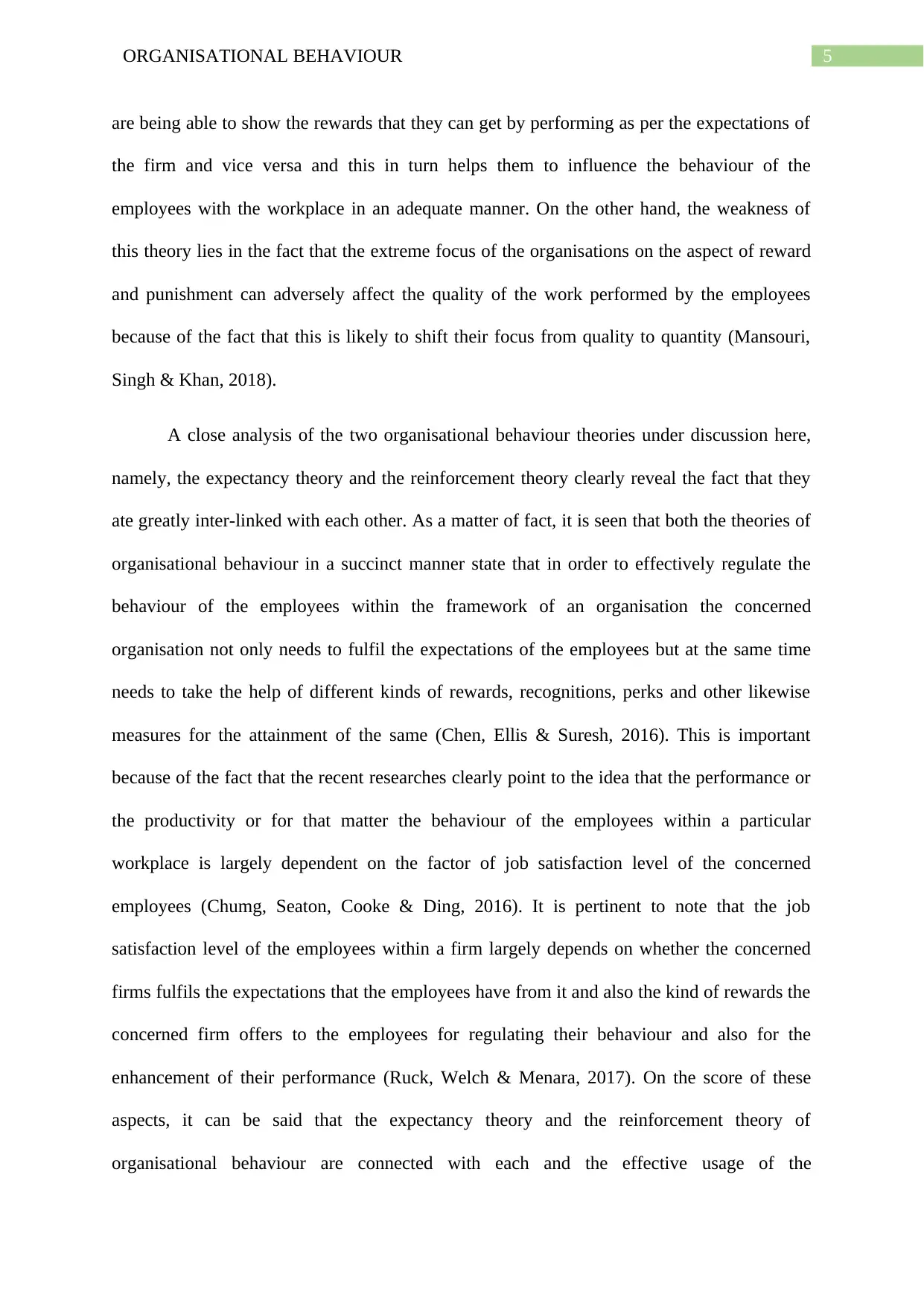
5ORGANISATIONAL BEHAVIOUR
are being able to show the rewards that they can get by performing as per the expectations of
the firm and vice versa and this in turn helps them to influence the behaviour of the
employees with the workplace in an adequate manner. On the other hand, the weakness of
this theory lies in the fact that the extreme focus of the organisations on the aspect of reward
and punishment can adversely affect the quality of the work performed by the employees
because of the fact that this is likely to shift their focus from quality to quantity (Mansouri,
Singh & Khan, 2018).
A close analysis of the two organisational behaviour theories under discussion here,
namely, the expectancy theory and the reinforcement theory clearly reveal the fact that they
ate greatly inter-linked with each other. As a matter of fact, it is seen that both the theories of
organisational behaviour in a succinct manner state that in order to effectively regulate the
behaviour of the employees within the framework of an organisation the concerned
organisation not only needs to fulfil the expectations of the employees but at the same time
needs to take the help of different kinds of rewards, recognitions, perks and other likewise
measures for the attainment of the same (Chen, Ellis & Suresh, 2016). This is important
because of the fact that the recent researches clearly point to the idea that the performance or
the productivity or for that matter the behaviour of the employees within a particular
workplace is largely dependent on the factor of job satisfaction level of the concerned
employees (Chumg, Seaton, Cooke & Ding, 2016). It is pertinent to note that the job
satisfaction level of the employees within a firm largely depends on whether the concerned
firms fulfils the expectations that the employees have from it and also the kind of rewards the
concerned firm offers to the employees for regulating their behaviour and also for the
enhancement of their performance (Ruck, Welch & Menara, 2017). On the score of these
aspects, it can be said that the expectancy theory and the reinforcement theory of
organisational behaviour are connected with each and the effective usage of the
are being able to show the rewards that they can get by performing as per the expectations of
the firm and vice versa and this in turn helps them to influence the behaviour of the
employees with the workplace in an adequate manner. On the other hand, the weakness of
this theory lies in the fact that the extreme focus of the organisations on the aspect of reward
and punishment can adversely affect the quality of the work performed by the employees
because of the fact that this is likely to shift their focus from quality to quantity (Mansouri,
Singh & Khan, 2018).
A close analysis of the two organisational behaviour theories under discussion here,
namely, the expectancy theory and the reinforcement theory clearly reveal the fact that they
ate greatly inter-linked with each other. As a matter of fact, it is seen that both the theories of
organisational behaviour in a succinct manner state that in order to effectively regulate the
behaviour of the employees within the framework of an organisation the concerned
organisation not only needs to fulfil the expectations of the employees but at the same time
needs to take the help of different kinds of rewards, recognitions, perks and other likewise
measures for the attainment of the same (Chen, Ellis & Suresh, 2016). This is important
because of the fact that the recent researches clearly point to the idea that the performance or
the productivity or for that matter the behaviour of the employees within a particular
workplace is largely dependent on the factor of job satisfaction level of the concerned
employees (Chumg, Seaton, Cooke & Ding, 2016). It is pertinent to note that the job
satisfaction level of the employees within a firm largely depends on whether the concerned
firms fulfils the expectations that the employees have from it and also the kind of rewards the
concerned firm offers to the employees for regulating their behaviour and also for the
enhancement of their performance (Ruck, Welch & Menara, 2017). On the score of these
aspects, it can be said that the expectancy theory and the reinforcement theory of
organisational behaviour are connected with each and the effective usage of the
⊘ This is a preview!⊘
Do you want full access?
Subscribe today to unlock all pages.

Trusted by 1+ million students worldwide
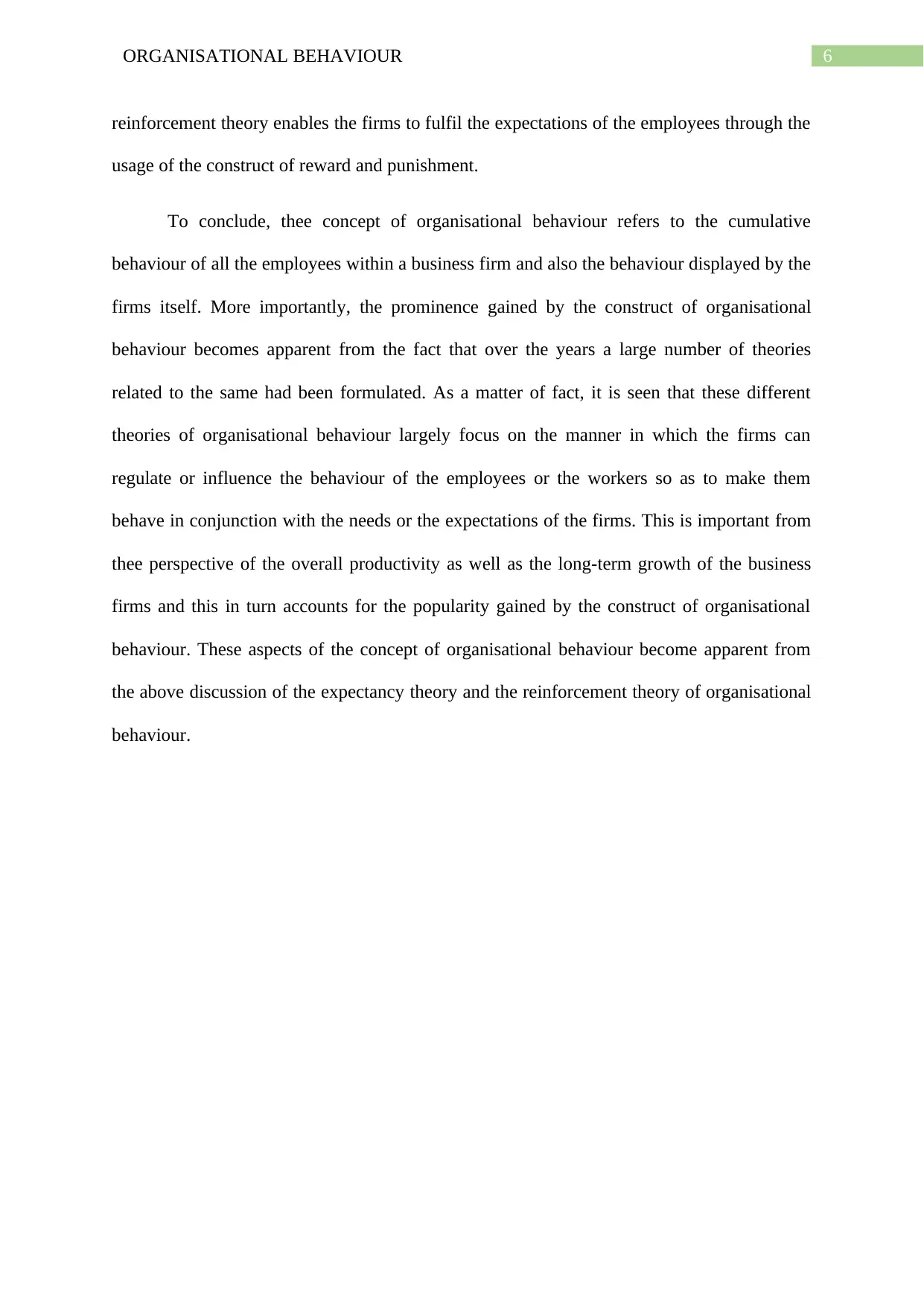
6ORGANISATIONAL BEHAVIOUR
reinforcement theory enables the firms to fulfil the expectations of the employees through the
usage of the construct of reward and punishment.
To conclude, thee concept of organisational behaviour refers to the cumulative
behaviour of all the employees within a business firm and also the behaviour displayed by the
firms itself. More importantly, the prominence gained by the construct of organisational
behaviour becomes apparent from the fact that over the years a large number of theories
related to the same had been formulated. As a matter of fact, it is seen that these different
theories of organisational behaviour largely focus on the manner in which the firms can
regulate or influence the behaviour of the employees or the workers so as to make them
behave in conjunction with the needs or the expectations of the firms. This is important from
thee perspective of the overall productivity as well as the long-term growth of the business
firms and this in turn accounts for the popularity gained by the construct of organisational
behaviour. These aspects of the concept of organisational behaviour become apparent from
the above discussion of the expectancy theory and the reinforcement theory of organisational
behaviour.
reinforcement theory enables the firms to fulfil the expectations of the employees through the
usage of the construct of reward and punishment.
To conclude, thee concept of organisational behaviour refers to the cumulative
behaviour of all the employees within a business firm and also the behaviour displayed by the
firms itself. More importantly, the prominence gained by the construct of organisational
behaviour becomes apparent from the fact that over the years a large number of theories
related to the same had been formulated. As a matter of fact, it is seen that these different
theories of organisational behaviour largely focus on the manner in which the firms can
regulate or influence the behaviour of the employees or the workers so as to make them
behave in conjunction with the needs or the expectations of the firms. This is important from
thee perspective of the overall productivity as well as the long-term growth of the business
firms and this in turn accounts for the popularity gained by the construct of organisational
behaviour. These aspects of the concept of organisational behaviour become apparent from
the above discussion of the expectancy theory and the reinforcement theory of organisational
behaviour.
Paraphrase This Document
Need a fresh take? Get an instant paraphrase of this document with our AI Paraphraser
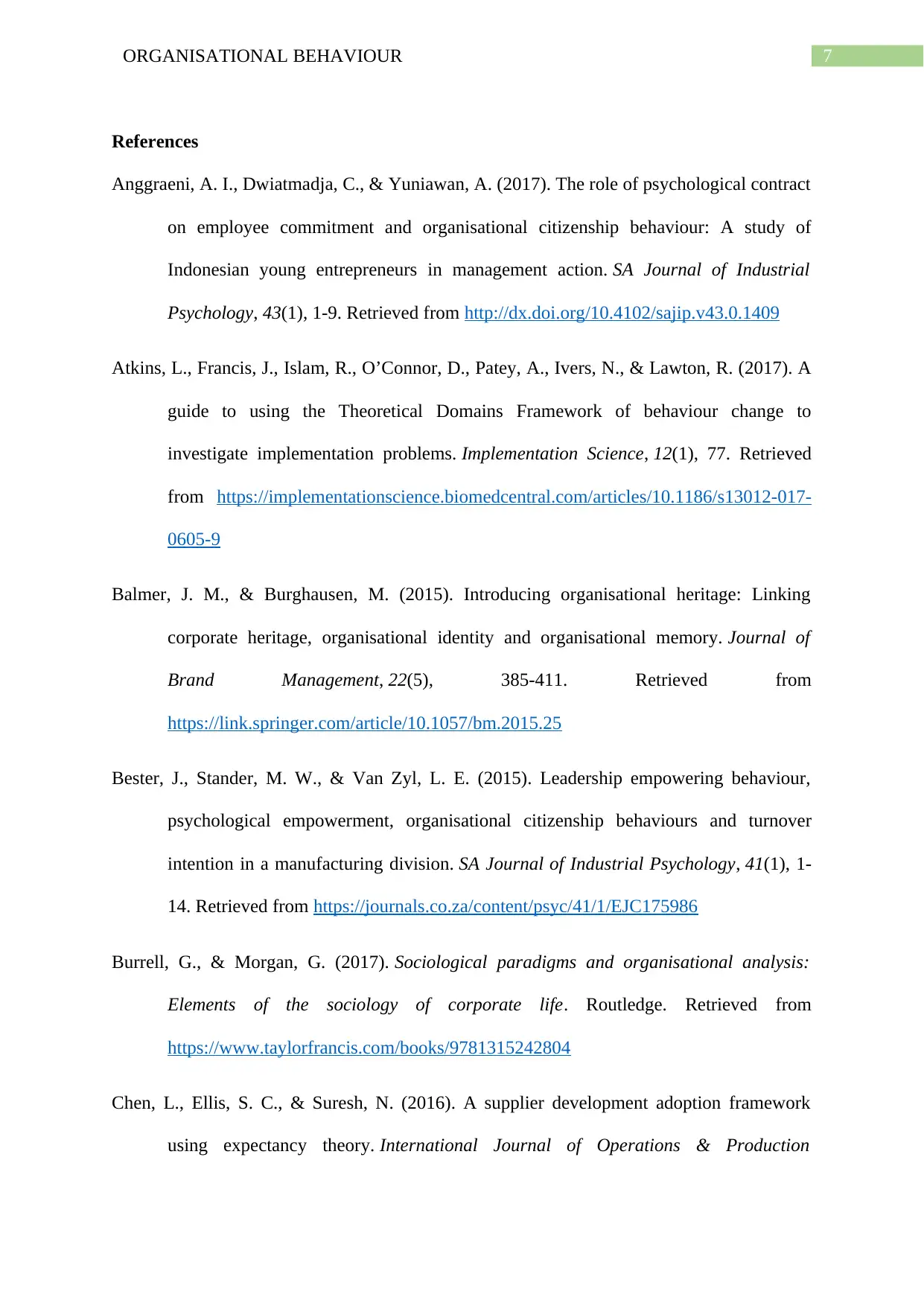
7ORGANISATIONAL BEHAVIOUR
References
Anggraeni, A. I., Dwiatmadja, C., & Yuniawan, A. (2017). The role of psychological contract
on employee commitment and organisational citizenship behaviour: A study of
Indonesian young entrepreneurs in management action. SA Journal of Industrial
Psychology, 43(1), 1-9. Retrieved from http://dx.doi.org/10.4102/sajip.v43.0.1409
Atkins, L., Francis, J., Islam, R., O’Connor, D., Patey, A., Ivers, N., & Lawton, R. (2017). A
guide to using the Theoretical Domains Framework of behaviour change to
investigate implementation problems. Implementation Science, 12(1), 77. Retrieved
from https://implementationscience.biomedcentral.com/articles/10.1186/s13012-017-
0605-9
Balmer, J. M., & Burghausen, M. (2015). Introducing organisational heritage: Linking
corporate heritage, organisational identity and organisational memory. Journal of
Brand Management, 22(5), 385-411. Retrieved from
https://link.springer.com/article/10.1057/bm.2015.25
Bester, J., Stander, M. W., & Van Zyl, L. E. (2015). Leadership empowering behaviour,
psychological empowerment, organisational citizenship behaviours and turnover
intention in a manufacturing division. SA Journal of Industrial Psychology, 41(1), 1-
14. Retrieved from https://journals.co.za/content/psyc/41/1/EJC175986
Burrell, G., & Morgan, G. (2017). Sociological paradigms and organisational analysis:
Elements of the sociology of corporate life. Routledge. Retrieved from
https://www.taylorfrancis.com/books/9781315242804
Chen, L., Ellis, S. C., & Suresh, N. (2016). A supplier development adoption framework
using expectancy theory. International Journal of Operations & Production
References
Anggraeni, A. I., Dwiatmadja, C., & Yuniawan, A. (2017). The role of psychological contract
on employee commitment and organisational citizenship behaviour: A study of
Indonesian young entrepreneurs in management action. SA Journal of Industrial
Psychology, 43(1), 1-9. Retrieved from http://dx.doi.org/10.4102/sajip.v43.0.1409
Atkins, L., Francis, J., Islam, R., O’Connor, D., Patey, A., Ivers, N., & Lawton, R. (2017). A
guide to using the Theoretical Domains Framework of behaviour change to
investigate implementation problems. Implementation Science, 12(1), 77. Retrieved
from https://implementationscience.biomedcentral.com/articles/10.1186/s13012-017-
0605-9
Balmer, J. M., & Burghausen, M. (2015). Introducing organisational heritage: Linking
corporate heritage, organisational identity and organisational memory. Journal of
Brand Management, 22(5), 385-411. Retrieved from
https://link.springer.com/article/10.1057/bm.2015.25
Bester, J., Stander, M. W., & Van Zyl, L. E. (2015). Leadership empowering behaviour,
psychological empowerment, organisational citizenship behaviours and turnover
intention in a manufacturing division. SA Journal of Industrial Psychology, 41(1), 1-
14. Retrieved from https://journals.co.za/content/psyc/41/1/EJC175986
Burrell, G., & Morgan, G. (2017). Sociological paradigms and organisational analysis:
Elements of the sociology of corporate life. Routledge. Retrieved from
https://www.taylorfrancis.com/books/9781315242804
Chen, L., Ellis, S. C., & Suresh, N. (2016). A supplier development adoption framework
using expectancy theory. International Journal of Operations & Production
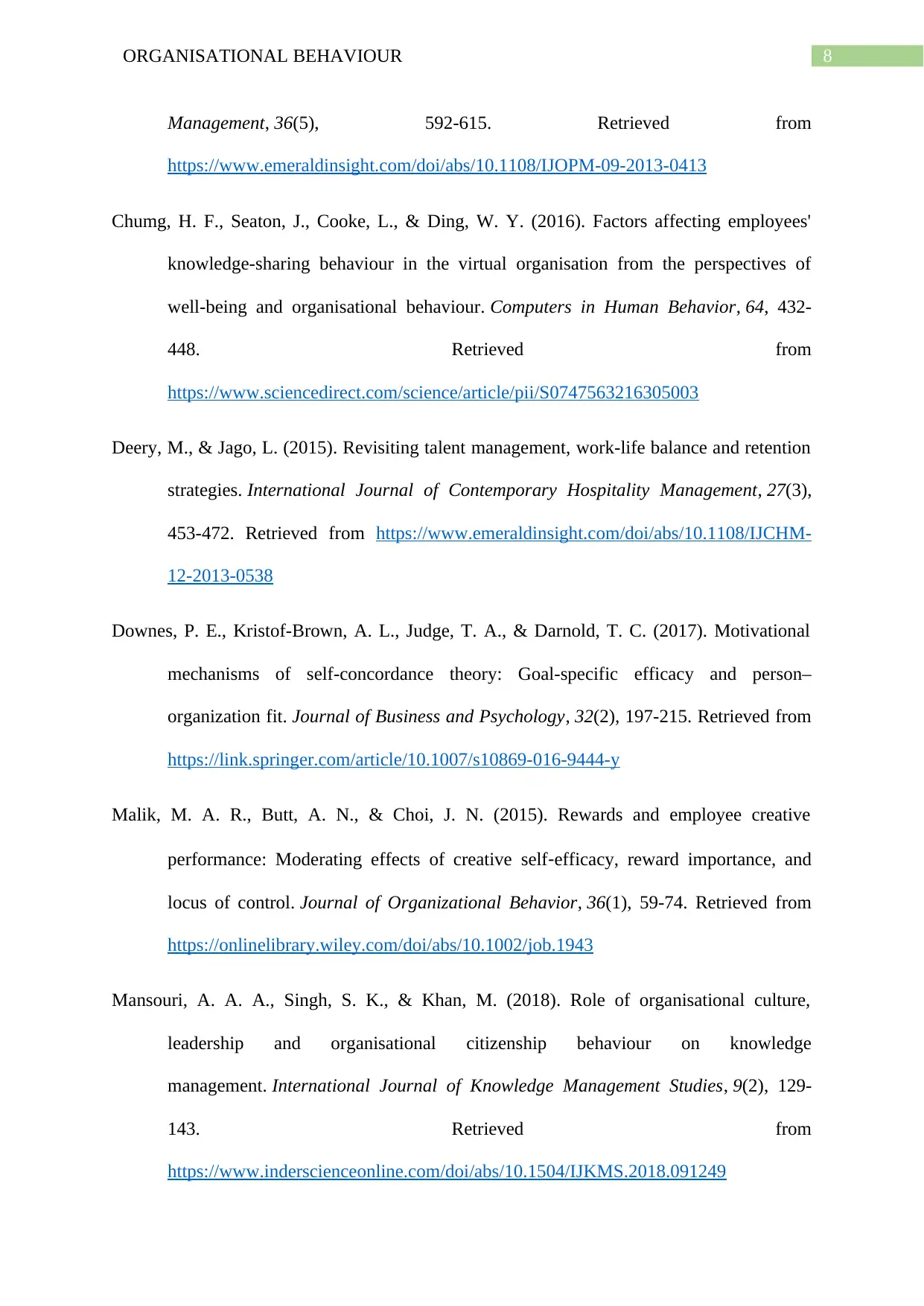
8ORGANISATIONAL BEHAVIOUR
Management, 36(5), 592-615. Retrieved from
https://www.emeraldinsight.com/doi/abs/10.1108/IJOPM-09-2013-0413
Chumg, H. F., Seaton, J., Cooke, L., & Ding, W. Y. (2016). Factors affecting employees'
knowledge-sharing behaviour in the virtual organisation from the perspectives of
well-being and organisational behaviour. Computers in Human Behavior, 64, 432-
448. Retrieved from
https://www.sciencedirect.com/science/article/pii/S0747563216305003
Deery, M., & Jago, L. (2015). Revisiting talent management, work-life balance and retention
strategies. International Journal of Contemporary Hospitality Management, 27(3),
453-472. Retrieved from https://www.emeraldinsight.com/doi/abs/10.1108/IJCHM-
12-2013-0538
Downes, P. E., Kristof-Brown, A. L., Judge, T. A., & Darnold, T. C. (2017). Motivational
mechanisms of self-concordance theory: Goal-specific efficacy and person–
organization fit. Journal of Business and Psychology, 32(2), 197-215. Retrieved from
https://link.springer.com/article/10.1007/s10869-016-9444-y
Malik, M. A. R., Butt, A. N., & Choi, J. N. (2015). Rewards and employee creative
performance: Moderating effects of creative self‐efficacy, reward importance, and
locus of control. Journal of Organizational Behavior, 36(1), 59-74. Retrieved from
https://onlinelibrary.wiley.com/doi/abs/10.1002/job.1943
Mansouri, A. A. A., Singh, S. K., & Khan, M. (2018). Role of organisational culture,
leadership and organisational citizenship behaviour on knowledge
management. International Journal of Knowledge Management Studies, 9(2), 129-
143. Retrieved from
https://www.inderscienceonline.com/doi/abs/10.1504/IJKMS.2018.091249
Management, 36(5), 592-615. Retrieved from
https://www.emeraldinsight.com/doi/abs/10.1108/IJOPM-09-2013-0413
Chumg, H. F., Seaton, J., Cooke, L., & Ding, W. Y. (2016). Factors affecting employees'
knowledge-sharing behaviour in the virtual organisation from the perspectives of
well-being and organisational behaviour. Computers in Human Behavior, 64, 432-
448. Retrieved from
https://www.sciencedirect.com/science/article/pii/S0747563216305003
Deery, M., & Jago, L. (2015). Revisiting talent management, work-life balance and retention
strategies. International Journal of Contemporary Hospitality Management, 27(3),
453-472. Retrieved from https://www.emeraldinsight.com/doi/abs/10.1108/IJCHM-
12-2013-0538
Downes, P. E., Kristof-Brown, A. L., Judge, T. A., & Darnold, T. C. (2017). Motivational
mechanisms of self-concordance theory: Goal-specific efficacy and person–
organization fit. Journal of Business and Psychology, 32(2), 197-215. Retrieved from
https://link.springer.com/article/10.1007/s10869-016-9444-y
Malik, M. A. R., Butt, A. N., & Choi, J. N. (2015). Rewards and employee creative
performance: Moderating effects of creative self‐efficacy, reward importance, and
locus of control. Journal of Organizational Behavior, 36(1), 59-74. Retrieved from
https://onlinelibrary.wiley.com/doi/abs/10.1002/job.1943
Mansouri, A. A. A., Singh, S. K., & Khan, M. (2018). Role of organisational culture,
leadership and organisational citizenship behaviour on knowledge
management. International Journal of Knowledge Management Studies, 9(2), 129-
143. Retrieved from
https://www.inderscienceonline.com/doi/abs/10.1504/IJKMS.2018.091249
⊘ This is a preview!⊘
Do you want full access?
Subscribe today to unlock all pages.

Trusted by 1+ million students worldwide
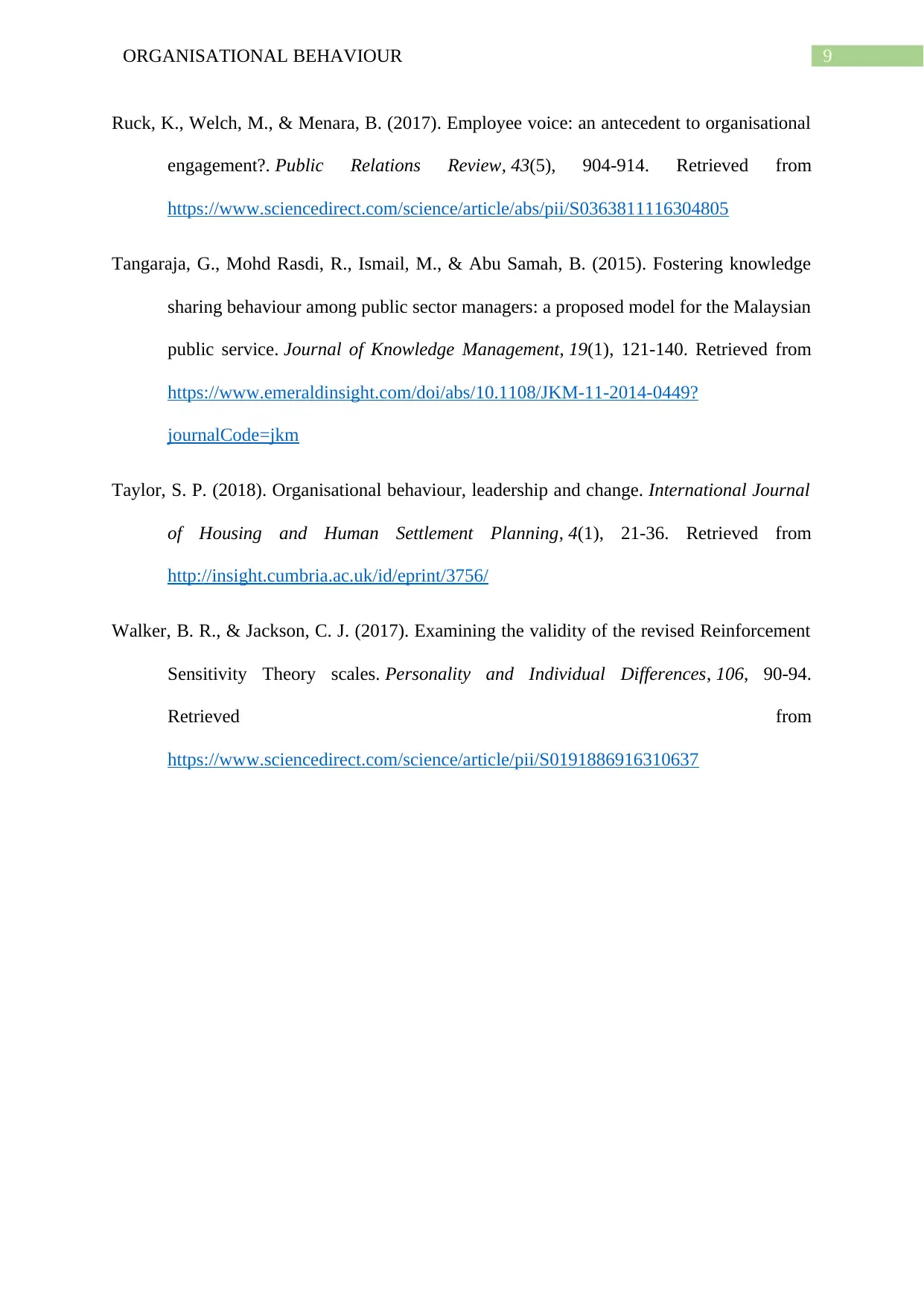
9ORGANISATIONAL BEHAVIOUR
Ruck, K., Welch, M., & Menara, B. (2017). Employee voice: an antecedent to organisational
engagement?. Public Relations Review, 43(5), 904-914. Retrieved from
https://www.sciencedirect.com/science/article/abs/pii/S0363811116304805
Tangaraja, G., Mohd Rasdi, R., Ismail, M., & Abu Samah, B. (2015). Fostering knowledge
sharing behaviour among public sector managers: a proposed model for the Malaysian
public service. Journal of Knowledge Management, 19(1), 121-140. Retrieved from
https://www.emeraldinsight.com/doi/abs/10.1108/JKM-11-2014-0449?
journalCode=jkm
Taylor, S. P. (2018). Organisational behaviour, leadership and change. International Journal
of Housing and Human Settlement Planning, 4(1), 21-36. Retrieved from
http://insight.cumbria.ac.uk/id/eprint/3756/
Walker, B. R., & Jackson, C. J. (2017). Examining the validity of the revised Reinforcement
Sensitivity Theory scales. Personality and Individual Differences, 106, 90-94.
Retrieved from
https://www.sciencedirect.com/science/article/pii/S0191886916310637
Ruck, K., Welch, M., & Menara, B. (2017). Employee voice: an antecedent to organisational
engagement?. Public Relations Review, 43(5), 904-914. Retrieved from
https://www.sciencedirect.com/science/article/abs/pii/S0363811116304805
Tangaraja, G., Mohd Rasdi, R., Ismail, M., & Abu Samah, B. (2015). Fostering knowledge
sharing behaviour among public sector managers: a proposed model for the Malaysian
public service. Journal of Knowledge Management, 19(1), 121-140. Retrieved from
https://www.emeraldinsight.com/doi/abs/10.1108/JKM-11-2014-0449?
journalCode=jkm
Taylor, S. P. (2018). Organisational behaviour, leadership and change. International Journal
of Housing and Human Settlement Planning, 4(1), 21-36. Retrieved from
http://insight.cumbria.ac.uk/id/eprint/3756/
Walker, B. R., & Jackson, C. J. (2017). Examining the validity of the revised Reinforcement
Sensitivity Theory scales. Personality and Individual Differences, 106, 90-94.
Retrieved from
https://www.sciencedirect.com/science/article/pii/S0191886916310637
1 out of 10
Related Documents
Your All-in-One AI-Powered Toolkit for Academic Success.
+13062052269
info@desklib.com
Available 24*7 on WhatsApp / Email
![[object Object]](/_next/static/media/star-bottom.7253800d.svg)
Unlock your academic potential
Copyright © 2020–2025 A2Z Services. All Rights Reserved. Developed and managed by ZUCOL.





